INDIA & AFGHANISTAN
- India and Afghanistan have had historical and cultural ties.
- India generally has good relations with those in power in Afghanistan, except the Taliban(1996-2001).
- India considered the Taliban to be a terrorist actor/group.
- In fact, 2012 Pakistan suggested distinguishing between "Good & Bad" Taliban.
- Good Taliban was a moderate variant of the Taliban.
- India refused any such distinction and did not engage in dialogue with the Taliban.
- The moderate version/variant of the Taliban was allowed to open a political office in Qatar, Doha in 2013.
- Regarding the Intra-Afghan dialogue, India has insisted the process be 'Afghan-Led, Afghan-Controlled & Afghan Owned'.
- In 2001 when the USA launched the Global War on Terror, it chose Pakistan as its major ally because of logistical purposes.
- The USA was dependent on Pakistan for communications and supply lines in its war against the Taliban.
- The USA was sensitive to Pakistan's security concerns and therefore recommended India limit its role to development assistance.
Indian state-building efforts in Afghanistan:
- India is Afghanistan's biggest regional development partner.
- During the last two decades, it has committed $ 3.1 billion in economic assistance., and around a million tonnes of wheat.
- Establishing Children’s Hospital.
- Building Afghan Parliament.
- Building Salma Dam, which is also known as India- Afghanistan Friendship Dam.
- India undertook the development of Chabahar port in Iran and also built 200 kilometers Zaranj- Delaram highway in Afghanistan to connect it to the Iranian border town of Zahedan.

- The project will reduce the dependence on land-locked Afghanistan over the Karachi port.
- Garland Highway of Afghanistan is connected to the Zaranj-Delaram Highway.
- Scholarships for college education, and an equal number entered into short-term vocational courses.
- Training Afghan civil servants and military officers.
- To strengthen local governance, India funded over four hundred small developmental projects across all 34 provinces of Afghanistan.
- These projects are demand-driven and have generated tremendous goodwill for India in Afghanistan.
- India spearheaded Afghanistan’s membership in SAARC.
WAY FORWARD BEFORE INDIA AFTER TALIBAN 2.0
- India should not be in any rush to recognize the Afghan government.
- It is a government based on Shariah law, disrespectful of women and minority rights.
- They have formed a Pashtun, Men-only government.
- However, Indian Afghan policy should be rooted in realism.
- India should pursue limited and gradual engagement.
- India should in fact establish direct contact with all actors in Afghan Polity including the National Resistance Front (NRF).
- NRF is the opposition group of the Taliban.
- India should continue providing humanitarian assistance.
- India should rethink its student-visa policy for Afghan students.
- India stopped issuing visas for many Afghan students who were pursuing courses in India.
- Currently, 14000 Afghan students are enrolled in India.
- Historically, India has been the most favored destination for Afghan students with 60,000 of them having completed their studies in the last 16 years.
- This will augment Indian soft power in India.
- India could also get more leverage over the Taliban through these steps.
Importance of Afghanistan:
- Location:
- Afghanistan is known as the roundabout of Asia.
- Through Afghanistan, one can access West Asia through Iran, South Asia through Pakistan, Central Asia through Tajikistan, and Southeast Asia through China.

- It is important to realize Indian strategic goals in erns of fostering closer ties between India, Central Asia, and Iran.
Resources:
- Afghanistan is rich in mineral resources and fossil fuels.
- It is expected to possess a trillion-dollar worth of rare-earth minerals in its mountains.
Pakistan’s Afghanistan policy:
- Pakistan's official policy is to seek strategic depth in Afghanistan in other words, Pakistan wants to have a puppet government in Afghanistan because:
- I. Pakistan suffers from a security dilemma( the source of the threat is another country).
- It is fearful that in case of a war with India if India has good relations with Afghanistan, it may open a second front against Pakistan.
- II. Pakistan also faces an insecurity dilemma( the source of threat is within the country, as the separatist demands of Pashtuns.
- The Durand Line is an imperial border drawn by the Britishers that had artificially divided the Pashtuns on either side of the Afghanistan - Pakistan border.
- These Pashtuns want to unify and create a Greater Pashtunistan.
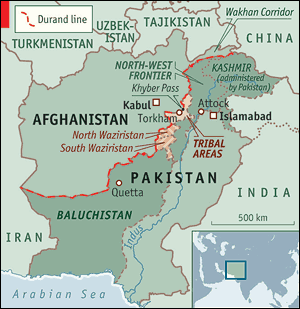
- If Pakistani Pahtuns of Khyber-Pakhtunkhwa (Pakistan) seek to join Afghan Pashtuns, Pakistani territorial integrity would be threatened.
- This is why Pakistan supported Taliban rule in Kabul.
TALIBAN 2.0 & PAKISTAN
- Though Rawalpindi(Pakistan Army headquarters) was initially triumphant after the Taliban's return to Kabul, the feeling was short-lived.
- Talibani's return emboldened Tehreek -E-Taliban Pakistan(TTP), which wants to establish an Islamic state in Pakistan.
- TTP has been engaged in many attacks in Khyber-Pakhtunkhwa and Balochistan.
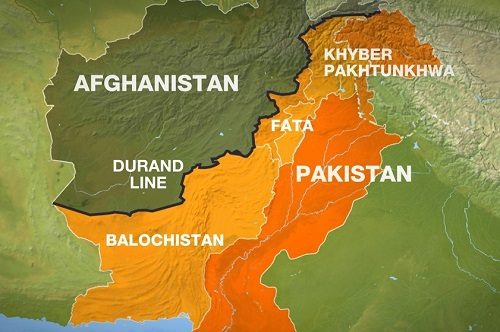
- Afghan Taliban has acted as a mediator between Pakistan & TTP.
- Through the mediation, a ceasefire agreement was concluded.
- The agreement helped TTP is regrouping and rearming while making Pakistan give many concessions.
- this has strained relations between Kabul & Islamabad.
- The ceasefire agreement collapsed in November 2022.
- Today Pakistan faces regular terrorist attacks from groups like ISIS-Khorasan & TTP.
- Pakistan blames Afghanistan for harboring these terrorists against it.
- Thus, the monster of terrorism that Pakistan created has eventually come to harm it.
Impact on India:
- Because of the strain on Taliban-Pakistan relations, the Taliban has increased its outreach to India to counter-balance Pakistan.
China in Afghanistan:
- China wants to contrast the Peshawar-Kabul motorway to include Afghanistan in the Chinese Belt & Road Initiative (BRI).
- Until recently Kabul was reluctant as it was concerned with the reaction of the USA.
- China has made investments in Afghanistan.
- China seeks the support of the Taliban to control the Uighur insurgency in its Xinjiang province.

- Uygurs are also present in Afghanistan as part of the ETIM- East Turkestan Islamic Movement.
- Beijing seeks the support of Islamabad for productively engaging with the Taliban.
- China and Afghanistan are linked by the Wakhan Corridor.

- Taliban 1.0(1996-2001 reign) could not capture the Wakhan Corridor, but Taliban 2.0 (after 2021) captured it.
- Tajikistan, POK, Afghanistan, China, and Pakistan share a border with the Wakhan corridor.
INDIA-BANGLADESH RELATIONS
- Strategic location:
- Bangladesh is located at a strategic wedge between Northeast India and the rest of India.
- India would benefit from a permanent transit agreement with Bangladesh which would help India overcome its Chicken's Neck dilemma.
- The Chicken's Neck or the Siliguri Corridor is 17 km wide at its narrowest point.
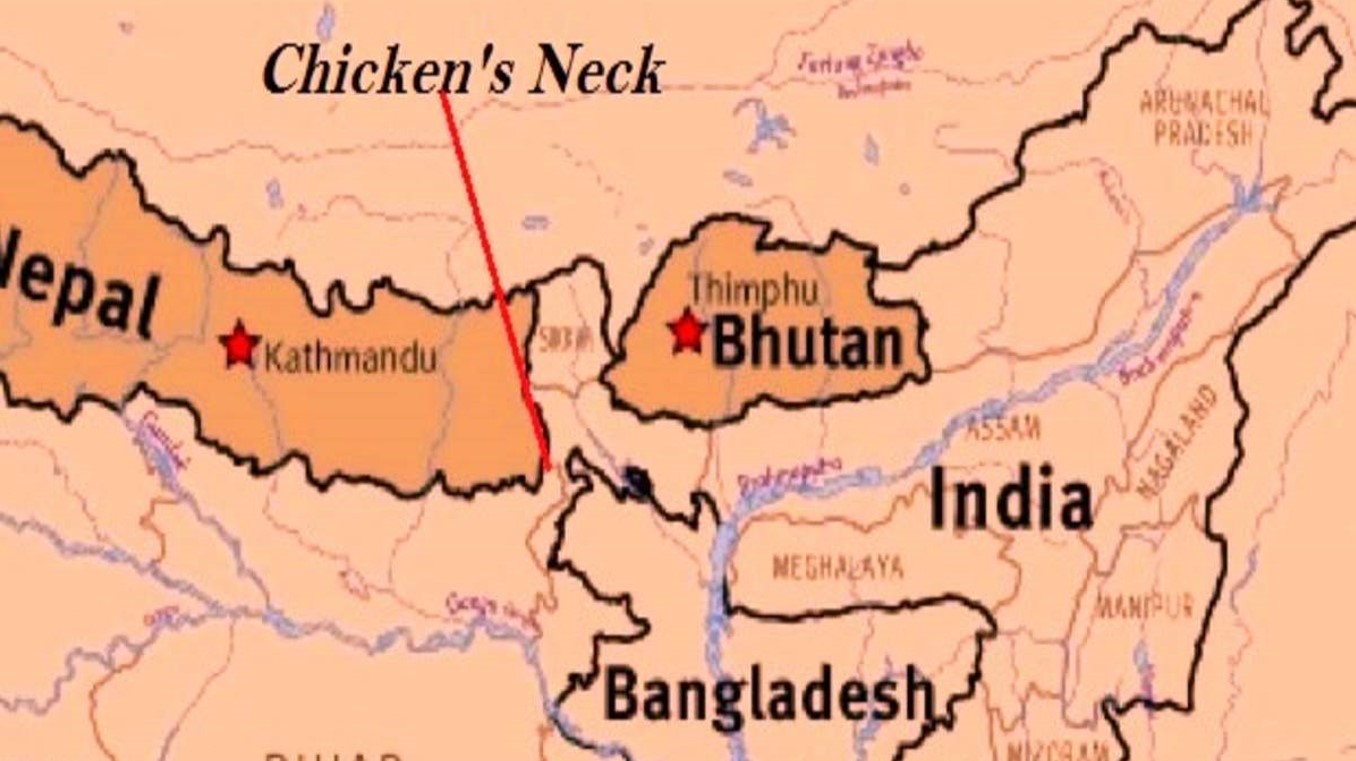
Security & development of North-east:
- Bangladesh provides a shorter route to the land-locked northeast.
- Bangladesh is its largest trade partner of India in South Asia.
- It acts as a land bridge for India's outreach to South-East Asia.
- Bangladesh is critical to Indian Initiatives such as BIMSTEC -Bay of Bengal Initiative for Multi-Sectoral Technical and Economic Cooperation.
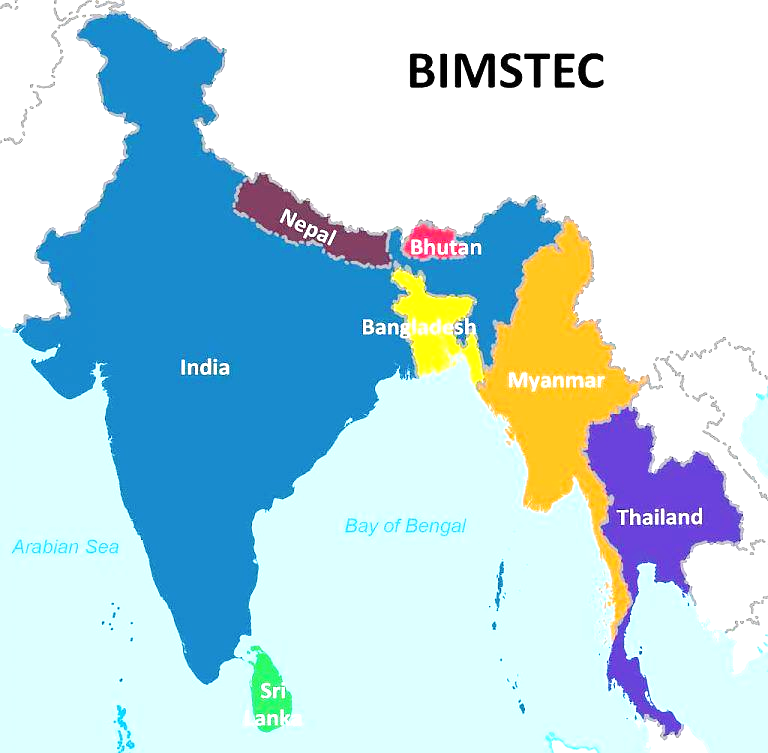
- Another such initiative is BBIN- (Bhutan-Bangladesh India & Nepal) Motor vehicle agreement.
Phases in bilateral ties:
Phase of relation Time period Nature of relation First 1971-1975 Very good Second 1975-1990 Lowest phase Third 1990 onwards
(Shonali Adhyay after 2014)Improvement in relations. - The first phase- 1971-1975:
- We had good relations with Bangladesh due to Indian help in the creation of Bangladesh.
- The India–Bangladesh Treaty of Friendship, Cooperation, and Peace was signed on 19 March 1972.
The second phase- 1975-1990:
- Relations soured after the assassination of Sheikh Mujibur Rahman and the period of military rule in Bangladesh.
- In fact, the Bangladeshi foreign policy of the time was driven by the primary agenda of distancing themselves from India.
Reasons for soured relations:
- At that period, the Bangladeshi army was mainly the repatriates of the Pakistani army that fought against India in 1971 and lost.
- There were some 26000 such expatriates.
- Bangladesh always had a strong communal undercurrent:
- The Muslim League was formed in Dhaka in 1906.
- Even during the 1971 war, there were certain sections that chose Islamic association with Pakistan over separate Bangladeshi identity.
- The Bangladeshi Army layer started portraying its Islamic identity.
- General Rahman and later General Irshad brought communal amendments to the Bangladeshi constitution.
- It is an irony that despite Indian pivotal role in the independence of Bangladesh, there is a lack of bipartisan consensus with respect to their relations with India.
- Relations improve when Awami League is in power and relations deteriorate when the BNP comes to power.
- China on the other hand enjoys bipartisan consensus in Bangladesh.
- China did not recognize Bangladesh till 1976.
THE THIRD PHASE:1990 ONWARDS
- After democracy returned to Bangladesh, we saw the betterment of relations.
- 1991-1996- BNP rule.
- 1996-2001- Awami League rule.
- 2001-2006- BNP rule.
- 2006-2009- Caretaker government.
- Awami League goth three consecutive election victories in 2009, 2014, and 2019.
- The recent three consecutive reigns of the Awami League are referred to as Golden Chapter in India-Bangaldesh relations or Shonali Adhyay.
- PM Sheikh Hasina has identified India-Bangkadesh relations to represent a model of good neighborliness.
- This is because India and Bangladesh are cooperating in conventional as well as non-conventional areas.
- Conventional areas- Health, Economics, people-people ties
- Non-Conventional areas- Civil Nuclear energy, Cyber connectivity, etc.
- Statement of Minister of External Affairs S Jaishankar- "Few countries in the world share such close fraternal ties."
Pieces of evidence of the Golden Phase in Bilateral ties:
- First Evidence: Land Boundary Agreement 2015:
- Through this, the two countries settled 6.5 kilometers of un-demarcated borders.
- A similar framework was signed in 1974, but t could not be implemented.
- Issues of Adverse Possessions arise because of rivers changing their courses given the riverine nature of a part of the India-Bangladesh border.
- Exchange of enclaves- Each other's territorial enclaves are present in another country.
- This agreement was operationalized through the 100th Constitution amendment act.
- The enclaves were swapped allowing the residents to choose citizenship of either of the countries.
Adverse Possessions:
- Indian “adverse possession” refers to territory within Indian control, which is legally part of Bangladesh.
- Residents of these adverse possessions are Indian citizens.
- The same applies to Bangladeshi adverse possessions.
- The reasons were seasonal changes in river courses and the fact that a good part of the India-Bangladesh border is riverine in nature.
Land Enclaves:
- It is a term used for the territory of one state that is completely surrounded by the territory of another state.
- It can be understood as a land island of a country, surrounded on all sides by the land ocean of another country.
- There were also some Second-degree or Third-degree enclaves which meant a portion of India was surrounded by a portion of Bangladesh which was itself surrounded by another portion of India, etc.
- The origin of such a situation is believed to be due to the fact that the Maharaja of Cooch Behar (presently in West Bengal) and Faujdar of Rangpur (presently in Bangladesh) wagered on these territories in their chess games and each lost many villages to the other.

- We need no constitutional amendment for settling boundary disputes with other nations and only executive order is enough.
- The 100th Constitutional Amendment was needed due to the issue of Land Enclaves.
- The LBA led to the transfer of 111 enclaves to Bangladesh while Bangladesh transferred 51 enclaves to India.
Second evidence: Maritime Boundary Settlement 2014:
- India did not contest the ruling of the Permanent Court of Arbitration's ruling that settled the dispute in favor of Bangladesh.
- It recognized the territorial rights of over 19,500 square kilometers of the adjoining Bay of Bengal to Bangladesh.
Third evidence: Actions against insurgents
- Shiekh Hasina's government adopted azero-tolerance policyagainst Indian insurgents in Bangladesh.
- Her government dismantled their camps, arrested and extradited their leaders to India.
Fourth Evidence: Connectivity:
- A direct Bus-service has been launched between Kolkata and Agartala via Bangladesh.
- It reduces the distance by 66%.
- Bangladesh has allowed the use of Chattogram and Mongla ports for the shipment of goods to and from North-East India.
- Recently, the Maitri Setu (Friendship Bridge) ( 1.9 km long) was inaugurated linking Sabroom in Tripura to Ramgarh In Bangladesh.
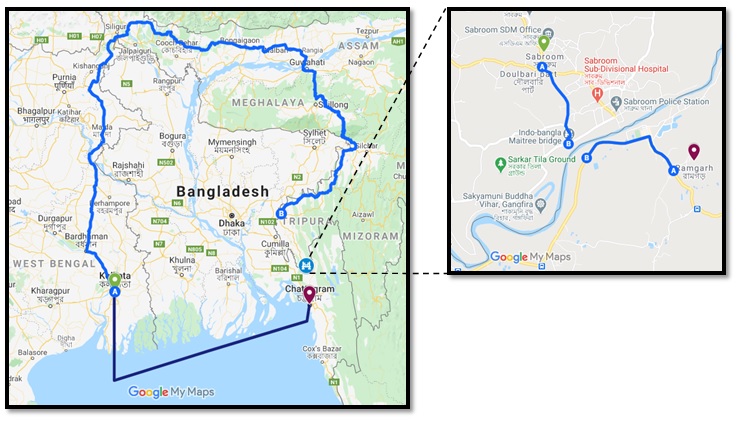
- A Friendship pipeline from Assam's Numaligarh oil refinery to Parvatipur in Bangladesh is near completion.
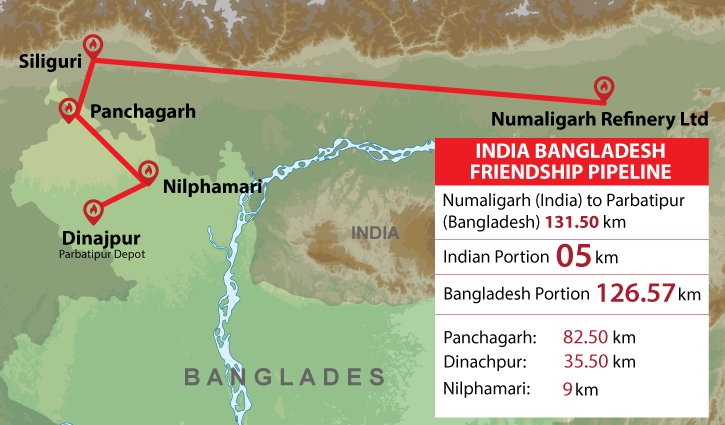
- Bangladesh has indicated its interest to join India-Myanmar-Thailand trilateral highway.

Fifth Evidence: Drinking water:
- Bangladesh has allowed the use of water from the Feni River to meet the drinking(potable) water needs of Sabroom town in Tripura.
Sixth Evidence: Infrastructure:
- Coal-Fired power plants are to be set up in Khulna in Bangladesh.
- India, Bangladesh, and Russia have concluded a trilateral agreement to develop the Rooppur Nuclear Power plant in Bangladesh.
Seventh Evidence: Trade:
- Bangladesh is India's largest trading trade partner in South Asia.
- Indis is the largest export market of Bangladesh.
- After 2015, China is the largest trade partner of Bangladesh.
- In the Financial Year 2022, our bilateral trade stood at 418 billion.
- We have decided to conclude a CEPA- Comprehensive Economic Partnership Agreement by 2026.
- The Least Developed Country (LDC) Status for Bangladesh would expire in 2026.
- That would end the duty-free, quota-free trade with India.
- The two countries want to conclude CEPA by 2026.
- According to World Bank, CEPA would increase Bangladeshi exports to India by 182 %.
- Along with other trade facilitation measures, It could push India-Bangladesh trade by 300%.
DEFENCE COOPERATION
- An MOU on the framework of defense cooperation has been concluded between India and Bangladesh.
- China also has a defense cooperation agreement with Bangladesh.
- China is the only country with which Bangladesh has a defense agreement, mainly due to its Pakistan legacy.
- India has provided a $500 million line of credit to Bangladesh for defense imports.
Bilateral Issues between India and Bangladesh:
Rohingya issue:
- They are believed to be of Bangladeshi origin and settled in the Rakhine state of Myanmar.
- They had been severely persecuted by the Junta regimes of Myanmar.
- They are also referred to as "Boat people", as they mainly use boats to flee to Bangladesh and Thailand.
- Around a million refugees have found shelters(mainly in Cox Bazaar) in Bangladesh which has created economic and security pressures for it.
- Thus, Bangladesh has insisted that India presses the issue with Myanmar to take back its citizens.
- However, India fearing that any such pressure would only push Myanmar more towards China has not undertaken such a diplomatic endeavor.
- Instead, it provided food tranches as humanitarian assistance to lessen the pressure on the state of Bangladesh.
Trade Deficit:
- Our bilateral trade in 2020-2021 was more than $ 18 billion.
- Out of this, Indian exports account for $ 16 billion and Bangladeshi exports are only around$ 2 billion.
- So Bangladesh experiences a trade deficit of $ 14 billion.
- Bangladesh has been classified as a Least Developed Country(LDC) till 2026.
- The status accords many trade benefits as no duties are levied on their goods.
- Bangladesh is apprehensive about the trade deficit after 2026.
Steps that were taken by India:
- India has provided lines of credit along with grants for assistance to Bangladesh.
- Bangladesh enjoys duty-free, quota-free trade agreements under SAFTA(South Asia Free Trade Agreement( 2011).
- Three SEZs have been notified in Bangladesh to encourage Indian manufacturers to manufacture in Bangladesh and export to India.
- Bangladesh's designation as LDC will expire in 2026 and the benefits of duty-free, quota-free trade access will come to an end.
- To continue Bangladesh's privileged access to Indian markets, both countries want to conclude CEPA ( Comprehensive Economic Partnership Agreement) before 2026.
River water sharing :
- India and Bangladesh share 54 transboundary rivers.
- Till now, an agreement has been signed over Ganga water sharing.
- An MOU has been signed in September 2022 for the Kushiyara River, under which Bangladesh can use 135 cusecs out of 2500 cusecs.
- 1 cusec indicates 28.32 Litres of water flowing per second.
Ganga River Sharing Agreement 1996:
- Context of the agreement:
- The Farakka Barrage was built on Ganga in 1975.
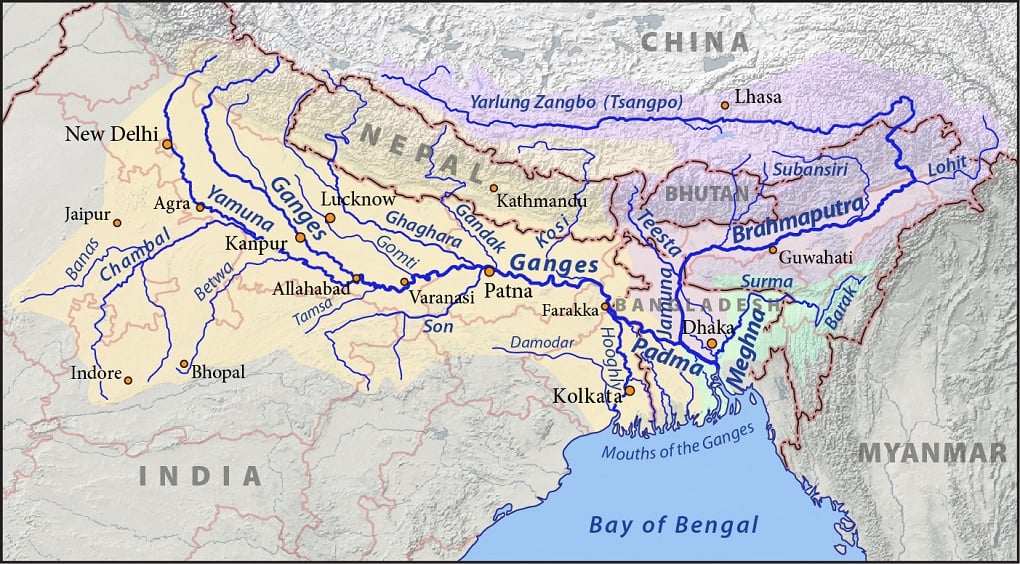
- The motive was to divert water to Ganga tributary Hooghly to was to reduce siltation and maintain the navigability of Kolkata port.
- Bangladesh says that during monsoon, the sluice gates of Farakka barrage are opened which causes flooding downstream, while Bangladesh faces drought during the dry season
Provisions of the treaty:
- The agreement is applicable for the lean period of the river- from 1st January to 31st May.
- The agreement was to be valid for 30 years and it is about to expire in 2026.
Availability of water Bangladesh's share Indian share Flow is below 70,000 cusecs 50% of the flow 50% of the flow Flow is between 70,000 and 75,000 cusecs 35,000 cusecs The remaining flow Flow is more than 75,000 cusecs The remaining flow 40,000 cusecs
Bangladesh's grievances:
- The treaty is based on outdated hydrological data and Ganga's flow seldom crosses 70,000 cusecs.
- Studies have shown that India has many times( more than 60 ) not fulfilled its obligations during drought phases.
- The treaty is based on areductionist approach, making the issue unidimensional and only based on volumetric river flow.
- A river performs multidimensional functions - WEBS services- Water, Ecosystem, Biodiversity & Sediments.
- Such an approach neglects the ecosystem services provided by the river.
Conclusion:
- The treaty's imminent expiry when the leadership in both countries are well entrenched to provide an opportunity to adequately revise this treaty.
- Various mechanisms can be explored as an improvement over the current river-water sharing agreement.
Teesta River:
- It originates in Sikkim and flows through West Bengal before entering Bangladesh.
- In Bangladesh, it is a tributary of Brahmaputra.

Importance of Teesta River for Bangladesh:- It covers 14 % of the total cropped area of Bangladesh and provides direct livelihood opportunities to 7.3 % of the Bangladeshi population.
Importance of Teesta River for India:
- Teesta is the lifeline of North Bengal and almost half a dozen districts depend on Teesta water.
Previous attempts at sharing Teesta River waters :
- In 1983, there was an Ad-hoc agreement (valid for two years) was signed.
- Under it, India's share was 39% of the river water flow, while Bangladesh was awarded 36%, and the remaining 25% of the water would flow freely into the Bay of Bengal or Brahmaputra.
In2011, an interim agreementto be valid for 15 years was put forth/proposed.
- According to it, India’s share would be 42.5 %, Bangladesh’s share would be 37.5 % and the remaining 20 % would remain unallocated.
- However, the agreement could not be finalized because of opposition from the State of West Bengal.
The demand of Bangladesh:
- It demands near equitable sharing of Teesta’s river water.
Stand of India:
- Since 71% of the watershed and the majority of its floodplains of Teesta lie in India, Bangladesh cannot demand equitable sharing.
- The flow of the river has decreased because of global warming.
- Many of the glaciers of the Teesta River have retreated/shrunk.
- The Chief Minister Of West Bengal has proposed sharing of other cross-border rivers such as Torsa, Manshai, Sankosh, etc.
- India and Bangladesh have signed an MOU on the Kushiyara River which is a distributary of the Barak River.
The topic for the next class is the continuation of India-Bangladesh bilateral issues.
1)
Consider the following statements:
1. Rohingyas are a Muslim group living mainly in Rakhine State on Bangladesh"s western coast.
2. They are treated as illegal immigrants in India and India does not have any domestic law on procedure or law that governs the protection of refugees in India.
Which of the given statements is/are Incorrect?
(a)1 only
(b)2 only
(c)Both 1 and 2
(d)None of the above.
2)
Considering the statements related to the Siliguri corridor-
1) India’s North East is geographically isolated from the rest of India and is connected to the mainland by a narrow strip of land called the Siliguri Corridor
2) Siliguri Corridor is a narrow stretch of land bordering Nepal, Bhutan, and Bangladesh.
Which of the following statements is correct?
(a)1 only
(b)2 only
(c)Both 1 and 2
(d)Neither 1 nor 2
3)
Which of the following is/are a member/s of the BIMSTEC?
- Myanmar.
- Nepal.
- Sri Lanka.
- Thailand.
- Laos.
- Cambodia.
Select the correct answer from the options given below:
(a)1,2, 3, 4, and 5 only
(b)1, 2, 3 and 4 only
(c)5 and 6 only
(d)1, 2 and 3 only
4)
Consider the following statements concerning the 2011 interim agreement on Teesta River water -
1. It was to be valid for 15 years.
2. According to it, India"s share would be 42.5% Bangladesh"s share be 37.5%, and the remaining would flow freely into the Bay of Bengal.
3. The demand for Bangladesh is equitable sharing.
How many of the statement(s) given above is/are correct?
(a)Only one
(b)Only two
(c)All three
(d)None
5)
Consider the following statements regarding Afghanistan as one of the important neighbours of India,
1. The Wakhan corridor lies between Afghanistan and Iran.
2. UNSC resolution 2593 advocated for the evacuation of people from Afghanistan post-Taliban takeover.
Which of the statements given above is/are correct?
(a)1 only
(b)2 only
(c)Both 1 and 2
(d)Neither 1 nor 2
6)
Delaram Zaranj highway and Garland highway, sometimes seen in the news, are located in:-
(a)Afghanistan
(b)India
(c)Pakistan
(d)China
7)
Consider the following nations:
1. Tajikistan.
2. Turkmenistan.
3. Afghanistan.
4. China.
How many of the above nations are connected to the Wakhan corridor?
(a)Only one
(b)Only two
(c)Only three
(d)All the four
8)
Consider the following statements
1. To implement the Land Boundary Agreement between India and Bangladesh 100th Constitutional Amendment Act was passed by the parliament.
2. Enclaves can be understood as a land portion of a country that is surrounded by another country.
3. The land boundary agreement led to the transfer of 51 enclaves to Bangladesh while Bangladesh transferred 111 enclaves to India.
Choose the correct answer from the codes given below:
(a)Only one statement is correct
(b)Only two statements are correct
(c)All the three statements are correct
(d)None of the three statements is correct
9)
What are the major pillars of India Bangladesh Relations? Critically analyze. (150 words/10marks)
10)
Bring about the Security Dilemma and the Insecurity Dilemma faced by Pakistan regarding Afghanistan. (150 words/10 marks)
11)
Critically analyse the outcomes of Indian approach towards Afghanistan in the last two decades. (150 words/10 marks)
12)
What are the issues that Bangladesh have with expiry of its Least Developed Coauntry Status in 2026, especially with respect to India ?( 150 words/10 marks)
13)
It is said that India enjoys large goodwill in Afghanistan. what are the reasons behind this ?(150 words/10 marks)
Answers
1) a
2) c
3) b
4) c
5) b
6) a
7) c
8) b
It is being argued that India Bangladesh Relation is witnessing a Golden Era. Discuss the statement with adequate examples. (150 words / 10 marks)
(10 marks)



0 Comments